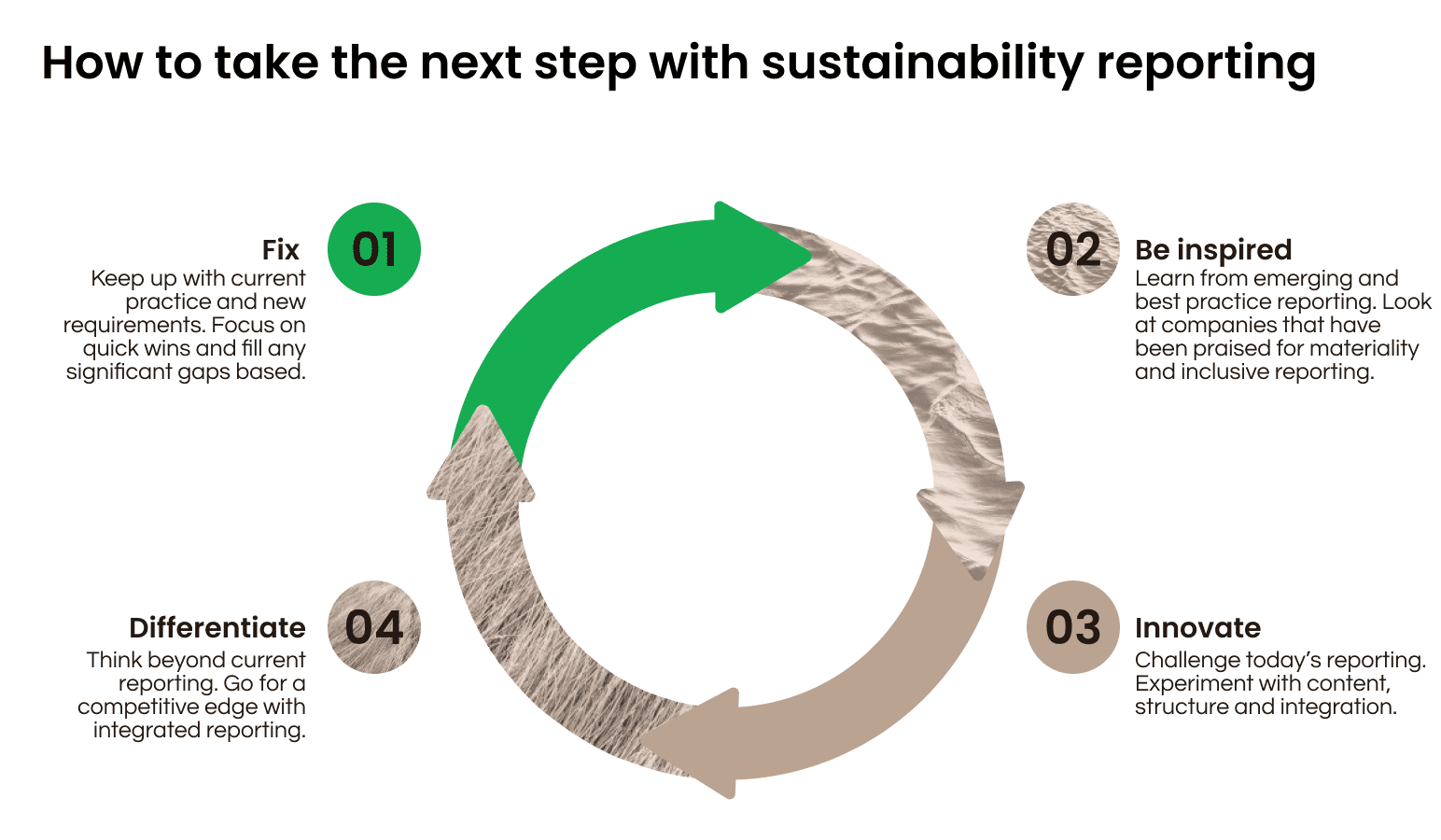 Step by step to become net zero
Step by step to become net zero

unsplash.com
What is an annual sustainability report?
Communicating sustainability is a rather complex task for organisations. A CSR or sustainability report is a periodical, usually annual, report published by companies with the goal of sharing their corporate sustainability actions and results.
Its purpose is to improve the transparency of the organisation’s activities. From an internal perspective, it achieves accurate and insightful data to improve processes and have a positive impact. From an external perspective, it allows companies to communicate CSR goals and sustainable development.
Writing and publishing an annual sustainability report is a key factor in a company’s sustainability strategy. With a global reporting initiative, a company can track its progress towards goals that align with its ESG strategy development. A report improves the effectiveness of a company’s monitoring system on sustainability metrics. It integrates active decision making and taking corrective actions while managing risks and opportunities.
The benefits of a sustainability report
- It gains trust and improves relationships with both internal and external stakeholders by facilitating open communication about material issues for your stakeholders;
- It enhances the reputation of how a company addresses sustainability and improves brand loyalty;
- It promotes internal operational efficiency and accountability which can lead to increased employee engagement;
- Lastly, it allows for communication on compliance to reporting regulations. Governments and regulators increasingly require or encourage companies to disclose sustainability information in their annual reports.
15 countries require some form of sustainability reporting from large companies, including South Africa, Singapore, New Zeeland, the UK, India, Denmark, Finland, France, Germany, Japan, Korea, Pakistan, the US, Malaysia, and Canada.
Here you can find all the different ESG reporting tools that you need to know.
This article offers you a broad approach to an annual sustainability report. If you wish to learn more on the subject, you can read here all the different ESG reporting tools that you need to know.
6 criteria of an effective sustainability report
The following are 6 key qualities every sustainability report should seek to adopt:
- Be aspirational yet action-oriented. It is about finding the right balance between intention, commitment through SMART targets, and measurement of impact is key.
- Be data-driven. The key lies in clearly identifying whether the organization is making progress in a reliable, accurate, and non-biased way.
- Communicate transparently and clearly. Report on the current efforts made and progress achieved without disregarding the negative impacts and challenges faced.
- Be consistent and comparable. Consistently reporting on efforts in relation to a benchmark is key and the reporting style should be in line with corporate reporting.
- Be authentic. Your report should reflect material issues, company values, and strategy. Being authentic will build trust, show alignment as well as commitment.
- Engage stakeholders. It is vital to engage and integrate stakeholder feedback to make your reporting complete, balanced, and create accountability.
How to choose a sustainability reporting framework?
Once you have identified what your sustainability report should achieve, the next question to ask is: Which reporting framework to choose? Sustainability communication strategies are developing continuously. Therefore there are a wide variety of reporting standards that have emerged over the past 20 years.
Selecting a framework depends on the scope of your report, your audience, the objectives, and purpose of the framework, and alignment between frameworks. Most importantly, the framework you select should fit your company’s needs and DNA. The following are two globally recognised standards:
- GRI reporting standards – World’s most widely used standards for disclosing sustainability impacts on the key pillars of governance, environment, social, ethical, and supply chain. The GRI standards can even be mapped in alignment with the Sustainable Development Goals (SDGs) and the Ten Principles of the United Nations Global Compact (UNGC). It is used by companies of all sizes and industries, from multinationals to SMEs and NGOs.
- 87% of sustainability reports referenced the GRI standards in 2019 (WBCSD, Reporting Matters)
- UNGC standards – A call to action for companies to fully integrate and align the Ten Guiding Principles into strategies, operations, and measurable outcomes. The Ten Guiding Principles address the key pillars of human rights, labor, environment, and anti-corruption.
More than 11000 companies across 157 countries have produced over 73000 reports in the last 20 years.
3 tips to make sure your sustainability report is read
Once you have written and published your sustainability report, the question remains: Is my report being read, and is it reaching my target audience? The following are three tips to make sure your report is read by your stakeholders:
- Use multiple communication channels thoughtfully. Ensure the medium, content, and style are tailored to both the audience and the message being delivered. For example, to avoid reading long reports some stakeholders tend to read specific sections that are most valuable to them.
- Use this insight to tailor specific areas of your report with the right medium. You could publish a press release, share across social channels, add success stories and case studies, or even host internal workshops.
- Ensure that what you report on speaks to your audience. When companies start writing an annual sustainability report the following question always pops-up: What exactly should I report on? Here is where the topic of materiality comes in. The assessment should identify what is material to your company as well as your stakeholders, only be reached if you actually speak to people from each stakeholder group.
- Be inspiring. Write your report in a way that speaks to your audience and engages them along the way. Follow a storyline that is captivating and inspiring to ensure readers will read your report from A to Z.

Taking the next step with sustainability reporting
Conclusion
Publishing an annual sustainability report is key in corporate governance. A report is relevant for all companies, not depending on size or industry. Considering the evolution of sustainability reporting is key for a successful reflection of ESG frameworks.
Such a CSR report makes sure that your sustainability KPIs are being communicated to the right stakeholders, creating greater transparency and therefore building trust and engagement. Find a more detailed guide to strengthen your sustainability reporting through our factsheet.
If you want to bring your reporting skills to the next level, you can also sign up for upcoming webinars hosted by Nexio Projects, around different reporting metrics such as new CSRD requirements and EcoVadis Assessment tips.











